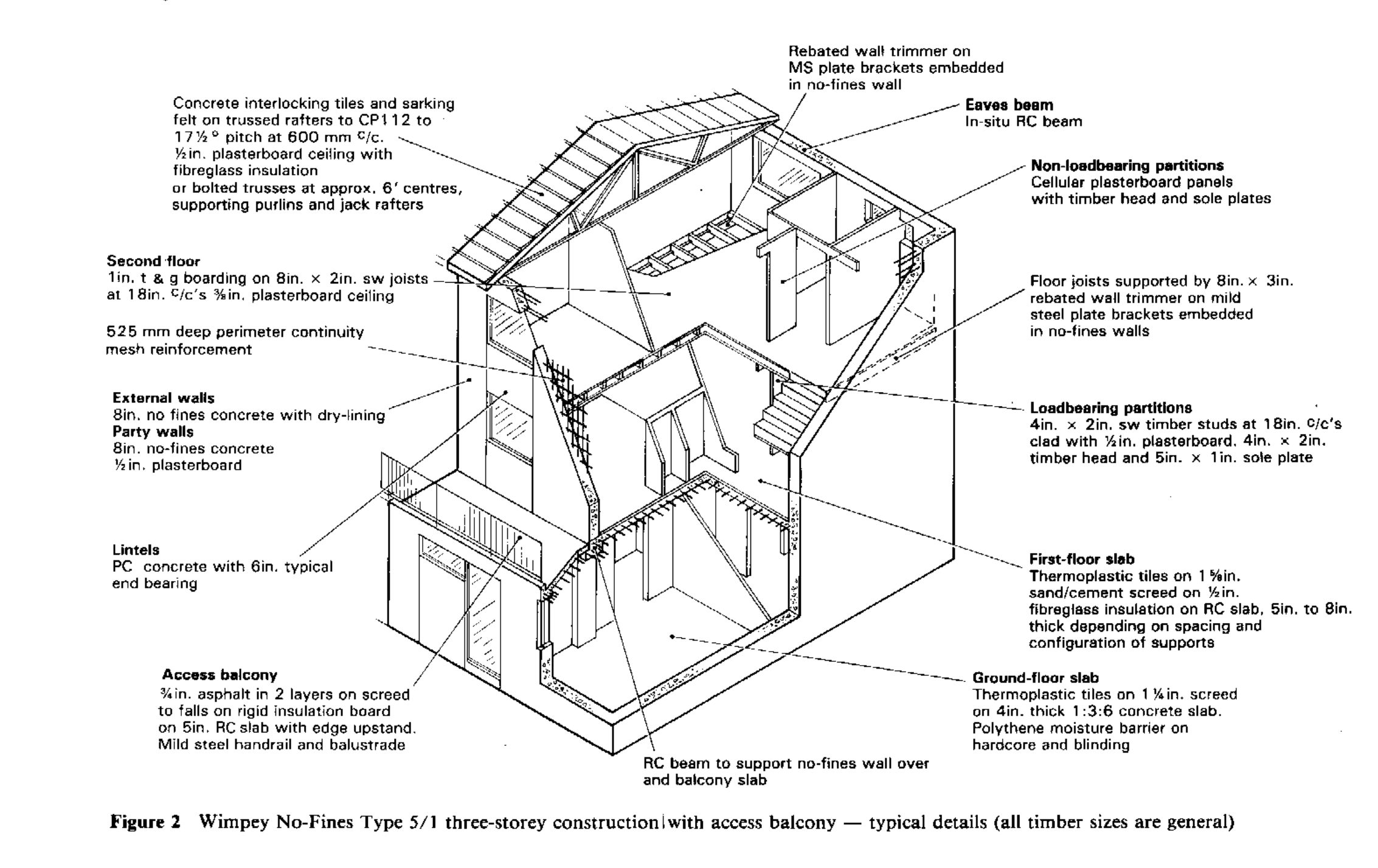Discover the fascinating world of Wimpey no-fines construction – a groundbreaking technique that revolutionised British post-war housing and continues to influence modern building methods.
In the aftermath of World War II, Britain faced an unprecedented housing crisis that demanded innovative solutions. Enter the Wimpey no-fines construction method – a revolutionary building technique that would go on to shape the landscape of post-war British housing and create over 300,000 homes across the nation.
The Origins and Historical Context of Wimpey No-Fines Housing
George Wimpey & Co. Ltd developed the no-fines construction method in response to the severe housing shortage following World War II. The technique was first introduced to Britain in the 1940s, though its origins can be traced back to Germany in the 1920s. The pressing need to house returning soldiers, displaced families, and a growing population meant that traditional brick-and-mortar construction methods were simply too slow and labour-intensive. Wimpey’s innovative approach offered a solution that was both rapid and economical. By 1975, more than 300,000 Wimpey no-fines houses had been built across the UK, particularly in urban areas like Birmingham, Gateshead, and London, where housing demand was highest.
Understanding No-Fines Concrete Construction
The term ‘no-fines’ refers to the unique concrete mixture used in this construction method. Unlike traditional concrete, which contains a mixture of fine aggregates (sand) and coarse aggregates (gravel), no-fines concrete eliminates the sand component entirely. This revolutionary mix consists of:
- Portland cement
- Coarse aggregate (typically 3/8 inch to 3/4 inch gravel)
- Water
- Minimal additives
The absence of fine aggregates creates a distinctive concrete structure with interconnected voids, offering several advantages:
- Enhanced thermal insulation properties
- Reduced material costs
- Lighter weight compared to traditional concrete
- Improved workability during construction
Key Features of Wimpey No-Fines Houses
Wimpey no-fines houses possess distinctive characteristics that set them apart from conventional construction. These properties typically feature:
- Concrete strip footings for solid foundations
- 10-inch thick reinforced concrete external walls
- Rendered exterior finishes
- Medium-pitched, tiled roofs
- Brick under-building
- Concrete ground floor slabs
- Timber stud partition walls internally
- Plasterboard wall linings
Structural Components and Building Techniques
The construction process of Wimpey no-fines houses was remarkably systematic and efficient. The walls were cast in-situ using specially designed formwork, which could be quickly erected and removed. Horizontal tie reinforcement was incorporated at strategic points to ensure structural stability, while precast concrete lintels were used above openings. The technique allowed for various house types, including:
- Semi-detached houses
- Terraced properties
- Bungalows
- Low-rise apartment blocks
Benefits and Advantages of No-Fines Construction
The Wimpey no-fines construction method offered numerous advantages that made it particularly suitable for post-war housing development. Studies have shown that these properties can provide up to 30% better thermal insulation compared to traditional brick construction of similar thickness. Key benefits include:
- Rapid construction speed – up to 50% faster than traditional methods
- Reduced labour requirements and costs
- Excellent thermal properties due to air voids in the concrete
- Good sound insulation characteristics
- Minimal waste during construction
- Versatility in architectural design
Common Issues and Maintenance Considerations
While Wimpey no-fines houses have generally performed well over the decades, they can experience certain issues that require attention. Common concerns include:
- Structural cracking, particularly around openings
- Deterioration of external render
- Damp penetration through poorly maintained surfaces
- Condensation issues if not properly ventilated
- Carbonation of concrete in some cases
Modern Implications and Property Considerations
Today, Wimpey no-fines houses present both opportunities and challenges in the property market. While these properties are not classified as defective under UK law, potential buyers and owners should consider:
- Mortgage availability – some lenders may require specialist surveys
- Insurance considerations – specialist providers may be needed
- Energy efficiency improvements – potential for cavity wall insulation
- Renovation possibilities – structural modifications may require expert assessment
The Legacy of Wimpey No-Fines Housing
The impact of Wimpey no-fines construction on British housing cannot be overstated. This innovative method helped address the critical post-war housing shortage and demonstrated the potential of mass-produced, efficient construction techniques. Today, an estimated 300,000 Wimpey no-fines houses remain in use across the UK, testament to their durability and effectiveness. The principles of rapid, cost-effective construction continue to influence modern building methods and prefabrication techniques.
Expert Insights and Recommendations
Industry professionals recommend several key considerations for those involved with Wimpey no-fines properties:
- Regular inspection of external render and prompt repairs when needed
- Maintenance of adequate ventilation to prevent condensation
- Professional assessment before any major structural modifications
- Consideration of external wall insulation for improved energy efficiency
- Retention of original documentation for mortgage and insurance purposes
Conclusion: The Future of Wimpey No-Fines Houses
Wimpey no-fines houses represent a significant chapter in British construction history, demonstrating how innovative thinking can solve pressing social challenges. While these properties may require specific maintenance considerations, their robust construction and unique characteristics continue to provide comfortable homes for thousands of families across the UK. As the construction industry faces new challenges around sustainability and housing provision, the lessons learned from the Wimpey no-fines experience remain relevant today. With proper maintenance and understanding of their unique properties, these houses can continue to serve as valuable assets in Britain’s housing stock for generations to come.
FAQ
How strong is no fine concrete?
This form of lightweight concrete is generally a crushed rock or gravel of 20 mm single size aggregate (10/20) coated in a cement slurry with no fine aggregate addition. Strength is between 5 and 15 N/mm2 at 28 days. It has good drainage properties due to its open texture.
Sources
[1] https://en.wikipedia.org/wiki/Wimpey_no-fines_house
[2] https://flettons.com/the-wimpey-no-fines-house-a-comprehensive-guide-for-home-buyers-and-investors/
[3] https://www.homesellingexpert.co.uk/guides/wimpey-no-fines-complete-guide


Leave a Reply